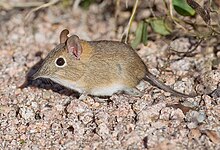
Back Klaasneuse Afrikaans زبابات الفيل Arabic Ukanol (Macroscelididae) AVK ماکروسلیدیده AZB Скакунчыкавыя Byelorussian Скакунчыкі BE-X-OLD Слонски земеровки Bulgarian Musaranyes elefant Catalan Macroscelididae CEB Bércouni Czech
| Elephant shrew[3] Temporal range:
| |
|---|---|

| |
| Black and rufous elephant shrew, Rhynchocyon petersi, Philadelphia Zoo | |
| Scientific classification | |
| Domain: | Eukaryota |
| Kingdom: | Animalia |
| Phylum: | Chordata |
| Class: | Mammalia |
| Infraclass: | Placentalia |
| Superorder: | Afrotheria |
| Grandorder: | Afroinsectiphilia |
| Mirorder: | Afroinsectivora |
| Order: | Macroscelidea Butler, 1956 |
| Family: | Macroscelididae Bonaparte, 1838 |
| Type genus | |
| Macroscelides A. Smith, 1829
| |
| Genera | |
|
Elephantulus | |

| |

| |
| Range map of elephant shrew by genus | |
Elephant shrews, also called jumping shrews or sengis, are small insectivorous mammals native to Africa, belonging to the family Macroscelididae, in the order Macroscelidea. Their traditional common English name "elephant shrew" comes from a perceived resemblance between their long noses and the trunk of an elephant, and their superficial similarity with shrews (family Soricidae) in the order Eulipotyphla. However, phylogenetic analysis has revealed that elephant shrews are not properly classified with true shrews, but are in fact more closely related to elephants than to shrews.[4] In 1997, the biologist Jonathan Kingdon proposed that they instead be called "sengis" (singular sengi),[5] a term derived from the Bantu languages of Africa, and in 1998, they were classified into the new clade Afrotheria.[6]



They are widely distributed across the southern part of Africa, and although common nowhere, can be found in almost any type of habitat, from the Namib Desert to boulder-strewn outcrops in South Africa to thick forest. One species, the North African elephant shrew, remains in the semi-arid, mountainous country in the far northwest of Africa. The Somali elephant shrew went unobserved from 1968 to 2020 but was rediscovered by a group of scientists in Djibouti.[7]
- ^ Martin Pickford; Brigitte Senut; Helke Mocke; Cécile Mourer-Chauviré; Jean-Claude Rage; Pierre Mein (2014). "Eocene aridity in southwestern Africa: timing of onset and biological consequences". Transactions of the Royal Society of South Africa. 69 (3): 139–144. doi:10.1080/0035919X.2014.933452. S2CID 128423895.
- ^ Martin Pickford (2015). "Chrysochloridae (Mammalia) from the Lutetian (Middle Eocene) of Black Crow, Namibia" (PDF). Communications of the Geological Survey of Namibia. 16: 105–113.
- ^ Schlitter, D.A. (2005). "Order Macroscelidea". In Wilson, D.E.; Reeder, D.M (eds.). Mammal Species of the World: A Taxonomic and Geographic Reference (3rd ed.). Johns Hopkins University Press. pp. 82–85. ISBN 978-0-8018-8221-0. OCLC 62265494.
- ^ Nishihara, Hidenori; Satta, Yoko; Nikaido, Masato; Thewissen, J. G. M.; Stanhope, Michael J.; Okada, Norihiro (2005). "A Retroposon Analysis of Afrotherian Phylogeny". Molecular Biology and Evolution. 22 (9): 1823–1833. doi:10.1093/molbev/msi179. PMID 15930154.
- ^ Kingdon, J. (1997). The Kingdon Field Guide to African Mammals. London: Academic Press. ISBN 978-0-691-11692-1.
- ^ Stanhope, M. J.; Waddell, V. G.; Madsen, O.; de Jong, W.; Hedges, S. B.; Cleven, G. C.; Kao, D.; Springer, M. S. (1998). "Molecular evidence for multiple origins of Insectivora and for a new order of endemic African insectivore mammals". Proceedings of the National Academy of Sciences. 95 (17): 9967–9972. Bibcode:1998PNAS...95.9967S. doi:10.1073/pnas.95.17.9967. PMC 21445. PMID 9707584.
- ^ Briggs, Helen (18 August 2020). "Elephant shrew rediscovered in Africa after 50 years". BBC News. Retrieved 19 August 2020.
© MMXXIII Rich X Search. We shall prevail. All rights reserved. Rich X Search